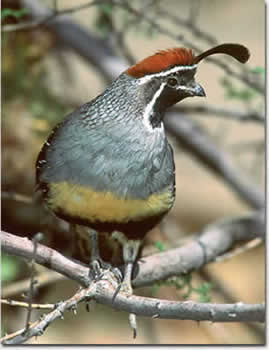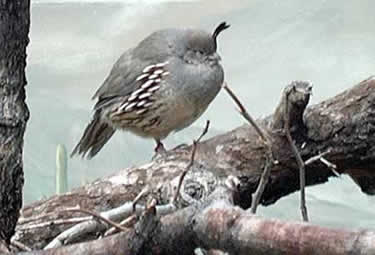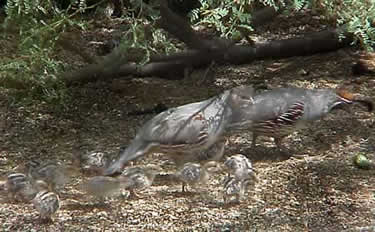|
 Gambel's
quail are found almost exclusively in the southwestern United States,
mainly in Arizona. Their range extends into Mexico, east to parts of Texas,
west to California and a small part of southern Utah, Nevada and Colorado.
A few quail were introduced to Hawaii in 1928, 1958 and 1960, and a few
remain there today. Gambel's
quail are found almost exclusively in the southwestern United States,
mainly in Arizona. Their range extends into Mexico, east to parts of Texas,
west to California and a small part of southern Utah, Nevada and Colorado.
A few quail were introduced to Hawaii in 1928, 1958 and 1960, and a few
remain there today.
Habitat
Gambel's Quail live in warm deserts with brushy and thorny vegetation.
These birds also survive well in cultivated communities and prefer mesquite
lined river valleys and drainages near these lands. Desert mountain foothills,
mesquite springs, plains with diverse vegetation and any area of the desert
receiving slightly more rainfall than surrounding parts, are all home
to good populations of Gambel's quail. These quail are non-migratory and
annual movements of the covey are less than 2 kilometers. Gambel's quail
prefer to roost in dense shrubs or trees at night. Shade from various
types of desert vegetation is also very helpful. Dense cover provides
shelter from predators. Common plants found in the quails' habitat include:
desert hackberry, mesquites, little leaf sumac, desert thorns, catclaw
acacia, scrub oak, and various other types of desert shrubbery.
Physical
Description
 Like
other quails, Gambel's quail have a chunky round body with a plume on
the head. Mature birds average eleven inches long and weigh from 160 to
200 grams. Males have a dark and thick plume, a black face and neck and
also a black patch on the breast. Females have more dull and thin plumes
and lack these black markings. Mature males have much more striking plumage
than females. This quail has chestnut sides, olive wings and various white
and cream-colored markings . Some variation in plumage occurs across its
range; mainly birds being darker and more vividly colored in areas with
more rainfall. Gambel's quail are known to hybridize with California and
Scaled quails, but this is not very common. Like
other quails, Gambel's quail have a chunky round body with a plume on
the head. Mature birds average eleven inches long and weigh from 160 to
200 grams. Males have a dark and thick plume, a black face and neck and
also a black patch on the breast. Females have more dull and thin plumes
and lack these black markings. Mature males have much more striking plumage
than females. This quail has chestnut sides, olive wings and various white
and cream-colored markings . Some variation in plumage occurs across its
range; mainly birds being darker and more vividly colored in areas with
more rainfall. Gambel's quail are known to hybridize with California and
Scaled quails, but this is not very common.
Gambel's
quail are considered monogamous, but sometimes a mature female will leave
young with the male and seek another brood with a new father. In order
to entice females, males offer small bits of food during feeding. Studies
have shown that the rate of this process, called "tidbitting,"
is the basis for a females' selection of a mate
 Female
quail select nest sites usually on the ground. Preferably the nest is
hidden under a shrub, rock, or protected site. Sometimes these quail may
build in a tree two to ten meters off the ground if a suitable platform
is available. The nest itself is bowl shaped, about four centimeters deep
and thirteen to eighteen centimeters wide. Small twigs, grass stems, leaves
and feathers line the nest. The eggs are dull white and are smooth, often
containing brown spots. Average clutch size is ten to twelve eggs. During
dryer years clutches tend to be smaller Female
quail select nest sites usually on the ground. Preferably the nest is
hidden under a shrub, rock, or protected site. Sometimes these quail may
build in a tree two to ten meters off the ground if a suitable platform
is available. The nest itself is bowl shaped, about four centimeters deep
and thirteen to eighteen centimeters wide. Small twigs, grass stems, leaves
and feathers line the nest. The eggs are dull white and are smooth, often
containing brown spots. Average clutch size is ten to twelve eggs. During
dryer years clutches tend to be smaller
Females
generally incubate the eggs for twenty-one to twenty-three days. Males
will attempt incubation if the female dies or is unavailable. Both parents
care for young, and if one parent dies the brood can be successfully raised
by the remaining parent. Young quail are capable of running around and
feeding soon after hatching.
Behavior
Gambel's quail are fast runners and only fly to escape danger, cross obstacles
like roads, or fly to a roost at night. They are not fast in flight and
prefer to remain on the ground if possible. The birds are not territorial
and population density depends on brood productivity, which varies depending
on yearly climate. A typical covey usually consists of an adult pair and
up to sixteen young. Each covey has a specific home range, but does not
defend this area and coveys commonly travel and feed in each other's home
ranges
 Food
Habits Food
Habits
Ninety percent of the Gambel's Quail diet comes from plants. Various types
of seeds and leaves are eaten throughout the year. During certain times
of year fruits and berries from cacti are eaten. A few insects are eaten
during the nesting season in spring and early summer. The quails feed
in groups while slowly traveling along the ground. Typically a covey feeds
twice a day, morning and afternoon. Communication between group members
is kept with calls. The birds typically rest in a shady area during the
hottest parts of the day. During cooler weather, the birds may feed and
remain active for longer time periods. The quail has little if any free
water requirements, but does prefer to live near and will frequent a water
source if one is available.
Predation
These quail prefer to remain motionless and rely on camouflage to avoid
predators, especially if hidden by vegetation. They are preyed on by a
wide diversity of small to medium avian, mammalian, and saurian predators
including snakes, raptors, foxes, bobcats, and coyote.
Thomson,
M. 2001. "Callipepla gambelii" (On-line), Animal Diversity
Web.
http://animaldiversity.ummz.umich.edu/site/accounts/information/Callipepla_gambelii.html.
|

 Gambel's
quail are found almost exclusively in the southwestern United States,
mainly in Arizona. Their range extends into Mexico, east to parts of Texas,
west to California and a small part of southern Utah, Nevada and Colorado.
A few quail were introduced to Hawaii in 1928, 1958 and 1960, and a few
remain there today.
Gambel's
quail are found almost exclusively in the southwestern United States,
mainly in Arizona. Their range extends into Mexico, east to parts of Texas,
west to California and a small part of southern Utah, Nevada and Colorado.
A few quail were introduced to Hawaii in 1928, 1958 and 1960, and a few
remain there today. Like
other quails, Gambel's quail have a chunky round body with a plume on
the head. Mature birds average eleven inches long and weigh from 160 to
200 grams. Males have a dark and thick plume, a black face and neck and
also a black patch on the breast. Females have more dull and thin plumes
and lack these black markings. Mature males have much more striking plumage
than females. This quail has chestnut sides, olive wings and various white
and cream-colored markings . Some variation in plumage occurs across its
range; mainly birds being darker and more vividly colored in areas with
more rainfall. Gambel's quail are known to hybridize with California and
Scaled quails, but this is not very common.
Like
other quails, Gambel's quail have a chunky round body with a plume on
the head. Mature birds average eleven inches long and weigh from 160 to
200 grams. Males have a dark and thick plume, a black face and neck and
also a black patch on the breast. Females have more dull and thin plumes
and lack these black markings. Mature males have much more striking plumage
than females. This quail has chestnut sides, olive wings and various white
and cream-colored markings . Some variation in plumage occurs across its
range; mainly birds being darker and more vividly colored in areas with
more rainfall. Gambel's quail are known to hybridize with California and
Scaled quails, but this is not very common. Female
quail select nest sites usually on the ground. Preferably the nest is
hidden under a shrub, rock, or protected site. Sometimes these quail may
build in a tree two to ten meters off the ground if a suitable platform
is available. The nest itself is bowl shaped, about four centimeters deep
and thirteen to eighteen centimeters wide. Small twigs, grass stems, leaves
and feathers line the nest. The eggs are dull white and are smooth, often
containing brown spots. Average clutch size is ten to twelve eggs. During
dryer years clutches tend to be smaller
Female
quail select nest sites usually on the ground. Preferably the nest is
hidden under a shrub, rock, or protected site. Sometimes these quail may
build in a tree two to ten meters off the ground if a suitable platform
is available. The nest itself is bowl shaped, about four centimeters deep
and thirteen to eighteen centimeters wide. Small twigs, grass stems, leaves
and feathers line the nest. The eggs are dull white and are smooth, often
containing brown spots. Average clutch size is ten to twelve eggs. During
dryer years clutches tend to be smaller Food
Habits
Food
Habits